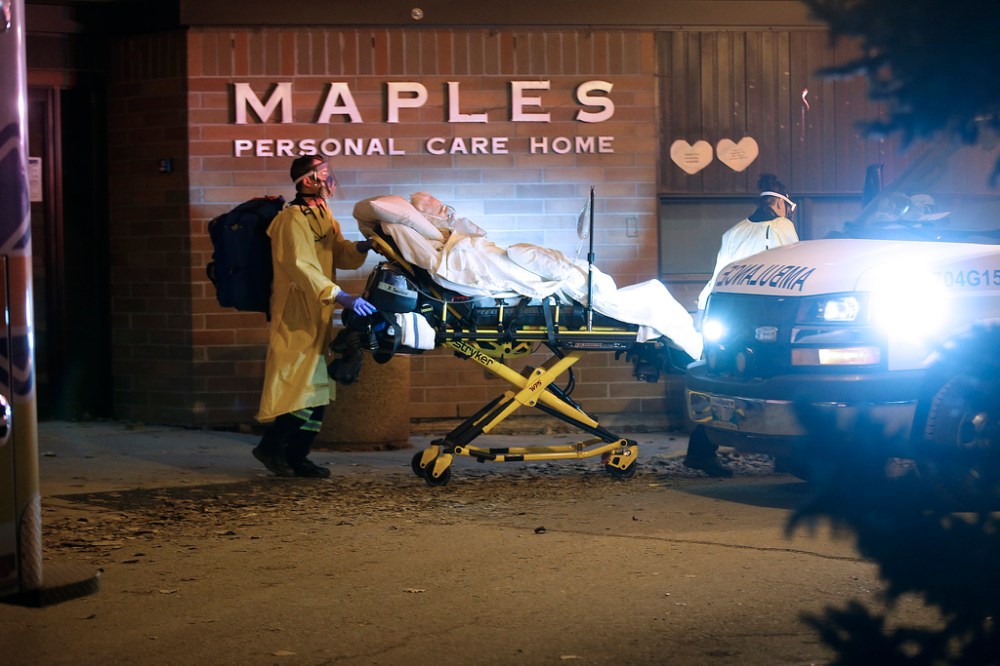Manitobans need to know why health system collapsed under COVID’s weight
Read this article for free:
or
Already have an account? Log in here »
To continue reading, please subscribe:
Monthly Digital Subscription
$0 for the first 4 weeks*
- Enjoy unlimited reading on winnipegfreepress.com
- Read the E-Edition, our digital replica newspaper
- Access News Break, our award-winning app
- Play interactive puzzles
*No charge for 4 weeks then price increases to the regular rate of $19.00 plus GST every four weeks. Offer available to new and qualified returning subscribers only. Cancel any time.
Monthly Digital Subscription
$4.75/week*
- Enjoy unlimited reading on winnipegfreepress.com
- Read the E-Edition, our digital replica newspaper
- Access News Break, our award-winning app
- Play interactive puzzles
*Billed as $19 plus GST every four weeks. Cancel any time.
To continue reading, please subscribe:
Add Free Press access to your Brandon Sun subscription for only an additional
$1 for the first 4 weeks*
*Your next subscription payment will increase by $1.00 and you will be charged $16.99 plus GST for four weeks. After four weeks, your payment will increase to $23.99 plus GST every four weeks.
Read unlimited articles for free today:
or
Already have an account? Log in here »
Hey there, time traveller!
This article was published 20/07/2021 (1603 days ago), so information in it may no longer be current.
Now that Manitoba hospitals have largely recovered from the third wave of the pandemic, the province should commission an independent review of why it was the only province in Canada to airlift COVID-19 patients out of province.
Manitoba’s hospitals were so overwhelmed in May and June, 57 critically-ill COVID-19 patients were sent to 16 different communities in Ontario, Saskatchewan and Alberta for medical care. The last one returned to Manitoba last Friday.
The question is, why was Manitoba the only province in Canada to do so?
Manitoba was hit harder than most jurisdictions in the country during the third wave, but it wasn’t the hardest hit. Alberta had the highest peak of COVID-19 infections, at 613 per 100,000 people over a 14-day period in early May. Manitoba was second, with a high of 475 per capita on May 22. Ontario was hit earlier and peaked at 402 in April. All other provinces had lower peaks.
The difference is that every province except Manitoba was able to treat critical-care patients inside its borders.
Was it because Manitoba has less hospital capacity than most provinces, including staffing? Did the Pallister government’s recent hospital consolidation plan contribute to the collapse, including corresponding hospital budget cuts? Were Manitoba’s COVID-19 patients more acutely ill than in other provinces, requiring longer stays in the ICU? Was it something else?
Manitobans deserve answers to these questions. Clearly, the province was not prepared for this public-health emergency. Airlifting patients out of province was not contemplated in Shared Health’s pandemic contingency plan unveiled last year. It was a last-ditch effort to save lives and it had mixed results.
The pandemic exposed a multitude of cracks in the province’s health-care system, including poor nursing-home oversight and a general lack of preparedness for large-scale public-health emergencies. There will be no shortage of post-mortems when this is all over.
However, one area that requires immediate attention is the woeful lack of surge capacity at acute-care hospitals, not only during a pandemic, but during normal respiratory-illness seasons.
Few, if any, health-care systems are built to absorb the kind of crushing demand COVID-19 imposed on Manitoba hospitals. However, even during normal times, Winnipeg hospitals operate very close to the margin with high bed-occupancy levels. There’s little room to accommodate sudden spikes in demand.
Average bed-occupancy levels at Winnipeg hospitals ranged from 90 to 100 per cent between 2016 and 2020, according to Winnipeg Regional Health Authority annual reports (not including Health Sciences Centre, which is now under Shared Health). The average was 92.3 per cent in 2019-20 prior to the pandemic. It was 100 per cent at Seven Oaks General Hospital last year and 97 per cent in 2016-17.

Average bed occupancy has increased at Grace Hospital to just over 93 per cent over the past two years, from 86 per cent prior to consolidation. It was 92.6 per cent at St. Boniface Hospital last year, down slightly from 96.5 per cent prior to consolidation.
The upshot is when hospitals get hit with a surge, as they do almost every year during flu season, they have little room to absorb the higher demand. They’re forced to reallocate resources from other parts of the hospital, including postponing elective surgeries, to staff more medical beds. It’s a regular feature of Manitoba’s hospital system and it contributes to substandard care. Elective surgeries were postponed in January 2020 (prior to the pandemic), 2018, 2013 and 2011 during flu seasons. Delaying surgical procedures to improve patient flow has negative, long-term effects on people. It’s a poor way to manage surges in hospital demand.
As the pandemic comes to an end, hospital capacity, including the catastrophic outcomes of the third wave, should be one of the first things to go under the microscope. Manitoba needs to be much better prepared for the next public-health emergency.
tom.brodbeck@freepress.mb.ca

Tom has been covering Manitoba politics since the early 1990s and joined the Winnipeg Free Press news team in 2019.
Our newsroom depends on a growing audience of readers to power our journalism. If you are not a paid reader, please consider becoming a subscriber.
Our newsroom depends on its audience of readers to power our journalism. Thank you for your support.






